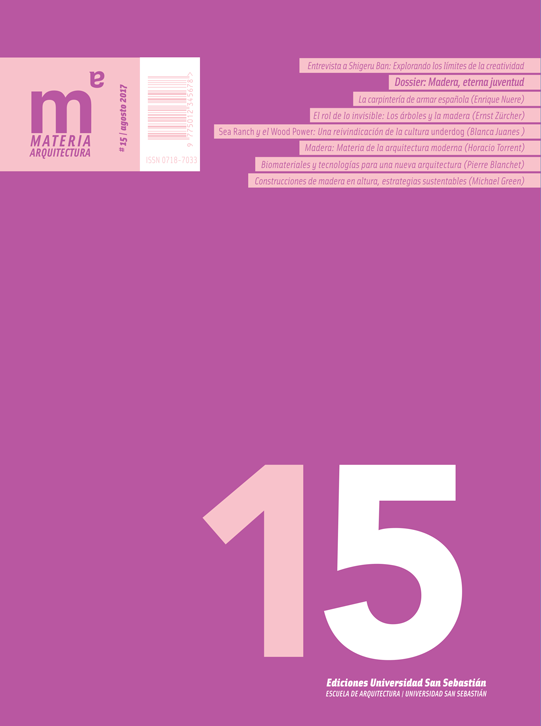Tall wood, strategies on sustainability for the cities of the future
Article Sidebar
Keywords:
Main Article Content
Abstract
Article Details
Materia Arquitectura provides immediate and free access to all the content of this online edition, published simultaneously with the print edition.
Materia Arquitectura does not charge authors for any concept.
All contents of this electronic edition are distributed under the Creative Commons license of "Attribución-shareAlike 4.0 Internacional" (CC-BY-SA).
The rights of the published texts and images belong to their authors, who grant Materia Arquitectura the license for their use. The management of the permits and the authorization of the publication of the images (or of any material) that contains copyright and its consequent rights of reproduction in this publication is the sole responsibility of the authors of the articles.
As long as they mention their origin, the authors are free to distribute their articles by other means. Any total or partial reproduction of the material must mention its origin.
Downloads
References
FRÜHWALD, A. (2007). The Ecology of Timber Utilization Life Cycle Assessment Carbon Management, etc. Probos Foundation. Kick off meeting CSR (Doorn, 15 de noviembre de 2007).
GREEN, M. (2011). The Case for Tall Wood Buildings. Vancouver, Canadá: MGB.
KOTHARI, M., & UN COMMISSION ON HUMAN RIGHTS. (2005). Report of the Special Rapporteur on Adequate Housing as a Component of the Right to an Adequate Standard of Living, Miloon Kothari. Ginebra: UN.
RETHINK WOOD. (2015). Evaluating the Carbon Footprint of Wood Buildings. Obtenido de www.rethinkwood.com/sites/default/files/Evaluating-Carbon-Footprint-CEU-Apr-2015.pdf
TURAK, T. (1986). William Le Baron Jenney: A Pioneer of Modern Architecture. Ann Arbor, MI, EE.UU.: Umi Research Press.
UN HABITAT. (2016). Urbanization and Development: Emerging Futures. World Cities Report 2016. Nairobi: UN Habitat.
UNITED NATIONS, DEPARTMENT OF ECONOMIC AND SOCIAL AFFAIRS, POPULATION DIVISION. (2014). World Urbanization Prospects: The 2014 Revision, Highlights (ST/ESA/SER.A/352). Nueva York: UN.
UNITED NATIONS, DEPARTMENT OF ECONOMIC AND SOCIAL AFFAIRS, POPULATION DIVISION. (2016). The World’s Cities in 2016. Nueva York: Data Booklet (ST/ESA/ SER.A/392). Obtenido de un.org: http://www.un.org/en/development/desa/population/publications/pdf/urbanization/the_worlds_cities_in_2016_data_booklet.pdf
US ENERGY INFORMATION ADMINISTRATION. (Marzo de 2011). Emissions of Greenhouse Gases in the United States, 2009. Obtenido de www.eia.gov: www.eia.gov/environment/emissions/ghg_report/pdf/0573%282009%29.pdf
US ENVIRONMENTAL PROTECTION AGENCY. (21 de noviembre de 2016). Greenhouse Gas Emissions from a Typical Passenger vehicle. Obtenido de www.epa.gov: www.epa.gov/greenvehicles/greenhouse-gas-emissions-typical-passenger-vehicle-0
WAUGH, A., HEINZ, K., & WELLS, M. (2009). A process revealed. Londres, Inglaterra: Thames and Hudson.
WORLDSTEEL ASSOCIATION. (2016). Steel’s contribution to a low carbon future, Worldsteel position paper. WSA.
Most read articles by the same author(s)
- Michael Green, Construcciones de madera en altura, estrategias sustentables para las ciudades del futuro , Materia Arquitectura: No. 15 (2017): Materia Arquitectura 15 (Agosto/August 2017)
